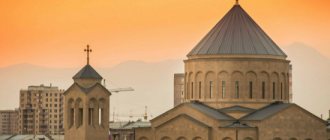Mata Hari once said: “ dance is a poem in which every movement is words .” From the very beginning of their journey, Armenians went through various difficulties and overcame them without losing their nationality.
A great way to prove this is through Armenian national dances, which are among the oldest in the Caucasus. They reflect the entire history of the country. When watching these dances, I want to read a poem about the history of Armenia. By dancing them yourself, you feel what the Armenians felt - all the struggle during the wars, strong faith in God, enormous strength, love for homeland and family and the happiness of victory.
Now let's look at some of the Armenian national dances that reflect the culture of the country.
Kochari
Kochari is a very famous dance in Armenia. Each region of Armenia dances Kochari with its own individual style (different movements and music). The word Kochari means "knee, come" (koh-knee, ari-come). John Blacking in one of his books mentioned: “a group dance where dancers imitate jumping goats is known as Kochari. The dancers stand in a line, holding hands, and the tempo of the dance varies from moderate to fast. Squats and butting an imaginary opponent are accompanied by high jumps.”
Armenian wedding traditions
Main features of an Armenian wedding
Armenians tie the knot strictly according to seniority - the older brother gets married first, and then the younger. There are also several prohibitions on marriage. Blood relatives cannot marry each other until the fourth, and in some cases until the seventh generation. Same-sex marriages between siblings are also prohibited. According to the laws of Armenia, adopted children and godfathers are also considered blood relatives, and prohibitions apply to them. Therefore, throughout the history of Armenia, not only godfathers, but also their children and grandchildren could not marry. Marriage with Muslims was also condemned before.
According to tradition, the bride had to be chosen from her native or nearby locality. Officially, Armenians can marry no more than three times, and the third time only with a widow. Exceptions and deviations from traditions, of course, took place, but they received serious public condemnation.
In Armenia people get married early. Suitable age for marriage is 12-16 years for a girl; 14-29 years old for guys. A girl who remained unmarried at the age of 17 was considered an old maid in Armenia, and at the age of 20 she was already called “overripe.” Traditionally, an Armenian wife should be several years younger than her husband. The age difference can reach 15-20 years. They tried to marry young men immediately after service, and marry off girls after she finished school.
Traditionally, an Armenian wedding was the main fact of creating a family, and the marriage was registered after the birth of the first child. If the spouses did not have children, then officially they were considered strangers. For the sake of their love, Armenian boys and girls are ready to do serious things. They could even disobey their parents and leave home if they did not consent to the wedding.
Marriage among Armenians is sacred and inviolable. Divorces are not encouraged and are very rare. Only the betrayal of one of the spouses can serve as a serious reason for such a step.
The main wedding traditions of Armenians have always been “bride kidnapping” and “arranged marriage”. In ancient times they were strictly observed, and today they are mostly beautiful ancient rituals.
Matchmaking ritual in Armenia
When a girl was chosen for their son, the groom's parents prepared for matchmaking. For negotiations with future matchmakers, they chose one of their closest relatives. Her task is to obtain the consent of the girl’s father for the wedding. When the mother of a potential bride found out that they wanted to marry her girl, she consulted her brother about this. They agreed on a matchmaking date, which took place a few days later. According to tradition, the groom's relatives came to the bride's house with an intermediary, and sometimes the groom's mother. At first, the future matchmakers greeted each other and talked about things completely unrelated to the wedding: the weather, politics, the garden, and other topics. And only then, with the help of proverbs, jokes and aphorisms, the matchmakers hinted why they came to visit.
Here is one of the typical examples of allegory. “We have come to take some water from your river into our river.” According to tradition, the matchmaker's proposal was never accepted immediately, even if the girl's parents agreed. They always found many reasons to stall for time, saying that they needed to think about such a serious proposal. And the matchmakers had to visit the Armenian bride’s house more than once.
After talking with relatives and asking his daughter’s consent, the girl’s father also announced his verdict in the original form: “Let’s not argue, let our bird fly to your garden.” According to tradition, this historical moment had to be sealed with a gift - a ring or some kind of jewelry for the girl. After the official part was completed, they set the table and drank the wine that the matchmakers brought.
Armenian “arranged marriage”
In ancient times, among the inhabitants of the Caucasus and among the Armenians, “arranged marriage” was common. This meant that even babies were betrothed. Parents who, for some reason, wanted to become related, agreed among themselves about the marriage of their children. As a sign of sealing the contract, they hung a piece of gold or silver on the cradle, and in some cases simply made a mark on it.
Later, the Armenian church banned “arranged marriage,” since no one is given the right to marry people without their consent. When a child grows up, he may want to connect his life with a completely different person. If the priest nevertheless decided to perform a wedding “by agreement,” he was punished. But the people could not imagine that such a wedding would not take place. This tradition almost disappeared at the end of the twentieth century, and today “arranged marriage” is only formal.
The bride for the Armenian youth was chosen by the father and, more importantly, the groom’s mother; she played the main role in this process. She noticed the girl, then consulted with her husband, brother and the rest of her relatives.
The groom's family collected information about the candidate bride and her relatives. From time immemorial, the best qualities of an Armenian girl have been: modesty, hard work, and education. Good health was highly valued so that she could give birth to strong children. The bride's appearance was in the background, the main thing was that she was a kind wife and a wonderful housewife. A girl's character was judged by her mother. It was believed that whatever a mother is like, her daughter will be like that in marriage.
Merry wedding celebrations
Traditionally, an Armenian wedding took place in winter or autumn, after the harvest was harvested. The main characters at the wedding celebration were “kavor” and “kavorkin” (married father and mother), as well as “azabs” (the groom’s single groomsmen). The groom's best friend was called at the wedding "azabbashi", which means "brother of the groom." A toastmaster was invited to an Armenian wedding, who made toasts and organized songs and dances. The host at the wedding is the father of the groom.
An ancient Armenian wedding lasted from three to seven days. This depended on the material well-being of the parents of the future spouses. The celebration began on Friday and ended on Sunday or the next week.
There are many interesting rituals in the Armenian wedding celebration. For example, bathing the newlyweds on the eve of the wedding, which symbolized their purification. The girl was bathed at home by her friends, and the boy was bathed by his friends in the barn. Bathing the bride was a solemn event; during this ritual, the girls sang and danced.
Wedding bread was baked at the bride or groom's home. Friends, to the sound of cheerful songs, sifted flour and kneaded dough.
The Armenian wedding celebration began simultaneously in the houses of the bride and groom. The groom's guests treated themselves as much as they wanted, then went home. And the groom, accompanied by his retinue and musicians, went to the bride’s house. A bull decorated with apples took part in this procession. Then, to the accompaniment of music and frantic dancing, the bull was slaughtered, and the blood of the killed animal was smeared on the groom's forehead. The future husband also smeared his dagger or knife with bull's blood, folded it and hid it in his pocket. The newlyweds opened this knife on their wedding night on the marital bed. The bull, according to Armenians, was considered a symbol of fertility, and this ritual was supposed to help in the birth of several children.
From the groom's house, the procession headed to the bride's house, who was waiting for her betrothed in the corner of her room behind a curtain. The bride's relatives met the groom's team at the gate and demanded a ransom. When the groom finally managed to get to the bride, the Armenian wedding feast began, which lasted for several hours. Then the guests gradually dispersed, and the groom and the “azabbashi” stayed overnight. Her friend spent the night with the bride.
You can find out how an Armenian groom comes to pick up his bride today from this video.
The next morning, the bride dressed behind a curtain. The young wife's girlfriends dressed her in a wedding dress to the tune of a sad Armenian melody. The ceremonial outfit was not much different from everyday clothes, but was made of expensive fabric. The girl's face was covered with a veil. Take a look at this photo and appreciate how charming the Armenian bride is.
A married man with many children carried the bride out and placed her next to the groom. He wished the newlyweds health, happiness and numerous offspring. The couple had to get married. Without performing such a ritual, the newlyweds did not have the right to go to bed together.
On the third day of the wedding, the wife came to her husband's house. The girl was transferred from his own hands to the hands of the new family by her father. He ordered the young husband to take care and protect his daughter. To the accompaniment of sad melodies, the wife said goodbye to her parents' house and, along with her dowry, went to her husband's house. There they were solemnly greeted by relatives and showered with sweets, nuts, grain and money. All symbols of happiness and wealth.
In Armenia, all wedding ceremonies were accompanied by refreshments, enchanting dances and fiery wedding songs. The festive table was rich in various treats, good wine, cognac, sweets and fruits.
Watch our video, in which an experienced toastmaster talks in detail about an Armenian wedding.
Post-wedding rituals and customs
In some regions of Armenia, the dowry was brought only after the end of the wedding celebration. This was the first post-wedding ritual. The second is washing the girl’s hair. A week after the wedding, the young wife’s mother came to the couple’s house. She brought with her soap, a comb, a towel, clothes for her daughter, and helped her wash her hair. In ancient times, this custom was observed very strictly - until this day, the mother could not see her daughter. Now this ritual has only symbolic meaning.
If you become a guest at an Armenian wedding, you will never forget this interesting and exciting event. Share with us your impressions of wedding celebrations in which you were a participant.
Yarkhushta
Martial dances are also very common in Armenia. One of the most popular of these is called Yarkhushta, which originates from the historical Armenian region of Sasun. This is from the category of Armenian “clapping dances”. The most important part of the dance is when the dancers, facing each other, clap each other's palms. Traditionally, before war, soldiers danced Yarkhushta to feel stronger and to awaken their fighting spirit.
Armenian version
Պարե՜ց Սասունը, ու ողջ աշխարհը հիացա՜վ, Պարե՜ց Սասունն, ու ողջ աշխար հը հասկացա՛վ, Որ պար չէ սա, այլ` երկրի հի՜ն պատմություն , Ուր պարտությ ուրտությու՛ն:
Գևորգ Էմին
Translation
Sasun danced, and the whole world was amazed, Sasun danced, and the whole world understood, That this dance is not just a dance, but the history of the old country, That history is a reason for pride.
Uzundara (bride dance)
Uzundara dance or bride's dance is an Armenian national lyrical dance. It originated in the valley between the villages of Agdam and Prishib in Karabakh. The word "Uzundara" means long valley. The Uzundara dance is very common at Armenian weddings, which is why it is often called the bride’s dance. The bride dances alone or with a group of other girls.
In the Uzundara dance, girls make various snake-like movements using their arms and body. The reason for this is that in Armenian mythology there was a snake with four heads, each of which represented a country. One of her non-poisonous heads represented Armenia.
The second is friendly people. The other two heads were poisonous and represented enemies. By making snake movements, the women distracted the poisonous heads of the snake.
The dance reflects the fighting spirit of Armenian women and how they are willing to fight alongside men to defend their country.
Echmiadzin
Etchmiadzin is a cult dance of the Karin . Despite the fact that it was performed back in pagan times (presumably the dance is dedicated to the worship of the Sun deity), now the dance is called after the main cathedral of the Armenian Apostolic Church, located in the city of Vagharshapat . The Etchmiadzin dance is danced in a circle, which then narrows and then becomes wider again. The narrow circle symbolizes sunset. 12 steps (6 to the left and 6 to the right) with slight inclinations are an expression of worship of the cult of the zodiacs in the pre-Christian period or the 12 apostles after the adoption of Christianity. Since the right side symbolized good luck and the left side symbolized bad luck, the dancers, by taking a step to the right and forward, maintained good luck within the circle/community, and by taking a step to the left, they renounced everything negative. In other words, Etchmiadzin is a kind of dance-prayer of a church or community.
Shalaho
One of the most famous and energetic Armenian dances is called Shalakho. There are different versions of the dance, but the most common is the dance in which two men fight to win the heart of their beloved woman.
Nowadays, both men and women dance shalaho at various events in Armenia. The women have slow and lyrical movements, like most Armenian dances. Men's movements are very different from women's. They dance faster and more energetically.
Shawali
Each event in ancient Armenia had its own traditions and dance. Shawali is a dance performed by the bride's relatives during the wedding. It was mainly danced in the Karin province of Western Armenia . Usually at weddings, the bride's relatives behaved passively and danced little. However, this dance was a mandatory wedding dance, during which the dancers, who should only be happy and married people, stand in a circle (the first to stand were the “parbashi” - the bride’s parents) and dance, holding their little fingers. Shawali could be danced by both women and middle-aged men.
Ververy
Ververi or Ver-ver is an Armenian group dance. The dance consists of two parts. The beginning of the song has a slow tempo. After a while the pace changes and becomes faster. The word "Ver" in Armenian means "up" and the word "Ververi" means to go up and up. Previously, this dance was called “Vernapar”, the meaning of which is “dance to the top”.
The dancers were usually young and strong men. They jumped very high, teaching children who had to grow up and be strong to protect their country. Also in Armenian mythology it is said that this dance will change the entire way of life of everyone existing in the world (including humans and animals).
If you ever visit Armenia, do not miss the opportunity to dance our national dances. By the way, you can even wear Taraz and feel the spirit of the Armenians to the fullest. We can guarantee that the emotions you get here will stay with you for a long time.











